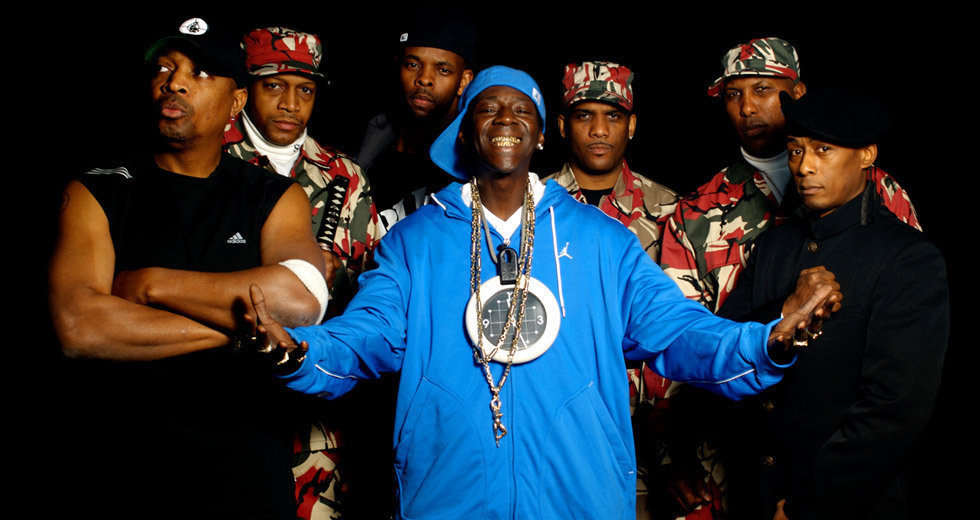The Infamous Tape Scene of Berlin’s Rap Underground
Juri Sternburg recounts a golden era of rap in the city
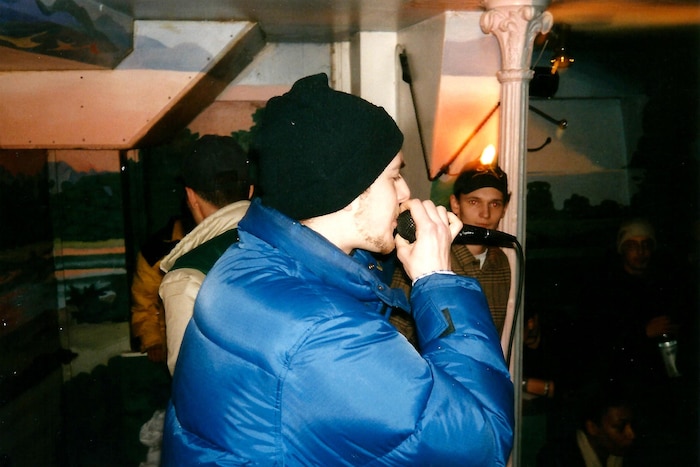
Berlin-Kreuzberg. It’s the end of the ’90s and my apartment is filled with everything a juvenile good-for-nothing could possibly need. A mattress (without a frame, of course), some random posters with a bunch of rappers on them, a bong, a malfunctioning TV, a handful of spray paint cans and a tape deck. None of my friends owned anything more than that. Smoke swirled through the air while we were hatching our graffiti sketches. This day-to-day scene was always accompanied by the appropriate soundtrack, blasting away from the tape deck: KRS-One or Cypress Hill, sometimes even tacky tracks out of the German-speaking rap world. Time passed and nothing seemed to change – until this one day. The doorbell rang and one of the many long-stay residents of the apartment – a pale and thin boy – arrived holding a new tape in his hands. It was a tape that would challenge everything we knew about rap.
The tape – (R)evolution, an album by German crew Die Lätzten, released on Bassboxxx – was our door opener to a whole new world dozing in the underground that would change German rap monumentally and forever. Something as raw, uncompromising and absurd was unheard and unknown to us. Within minutes, everyone present came to a silent agreement: From now on, this would be blasting from the tape deck constantly. At the time, because the major label industry’s only focus was signing German imitations of US-based and comical college rappers, you depended on the nerds and experts in your circle, the know-it-alls, to thrust a tape in your hand with an amiable pat on the back and a look that said, “Thank me later, pal.” This moment had finally come.
The starting point of Deutschrap’s evolution reaches back to the infamous tape scene, where the biggest contemporary artists in Germany cut their teeth in a musty basement.
Fast-forward 20 years. Deutschrap has become the most dominating genre in German music. As long as Pink Floyd is not releasing an album that same week, the top of the charts is usually occupied by an MC. The starting point of the genre’s evolution reaches back to the infamous tape scene, where the biggest contemporary artists in Germany cut their teeth in a musty basement. Even though the hype around it only lasted for around three or four years, the scene’s cultural value and influence is still prevalent and worshipped to this day.
The label Royal Bunker – originally a freestyle battle format in a musty basement of the same name – became the melting pot of underground rap in the late ’90s. For artists that later rose to gold and platinum status like Sido, Kool Savas and Frauenarzt, this was their place of choice. The basement-slash-bar counts as the place of birth for West Berlin’s battle rap culture. When looking for the former gathering place in 2018, there is only a brothel to be found. After the pub had to close down due to rental arrears from the previous owner in 1998, some of the rappers looked around for new platforms to promote their music. The erstwhile companions and friends split up in different camps and focussed on their music. As a result, a golden era for Berlin rap arose and with it thousands of tapes.
In a Turkish restaurant in Berlin-Kreuzberg, I meet with Marcus Staiger, founder of the label Royal Bunker and jointly responsible for the discovery and promotion of some of the most relevant rap acts in Germany. Although he works as a journalist and industry climber nowadays, he still has one foot in Deutschrap’s door that he was never fully able to withdraw. Staiger might be the most defining person in Berlin’s early tape scene. Among other things, he is to thank for the development of a tape culture as such that set new historical standards within the genre.
“Releasing tapes was basically the only opportunity we had to release our stuff,” Staiger says, while stirring his tea. “Most of the other people from Berlin just dreamt about a major deal even though the music industry barely existed in Berlin back then. They all came later. The fall of the Wall was still very recent.”
Inspired by the tape releases of the punk scene and mixtapes by hip-hop disc jockeys, Staiger called DJ Hype – who was a staple in the scene – to drill down on the production of tapes. From this point, he forged the plan to found a tape label and bring out music that no other label would ever release. “This was unthinkable for so many artists and beneath their dignity. We didn’t care. We just wanted to release our stuff and vinyl was way too expensive.” According to many companions, Staiger had the reputation of being a bad businessman who was missing a necessary capitalist mentality. Still, he proved to have an ear for upcoming artists who were rejected by the mainstream music industry.
Similar to the development of rap in the US, music from the underground was regarded as commercial poison.
“We were the dregs of the scene. No one wanted to support the unprofessional and asocial shit we did,” Justus Jonas laughs. He is a founding member and rapper of the renowned collective M.O.R.(Masters of Rap) who set one of the first musical milestones of linguistically ambitious German battle rap with their album NLP. Sitting in an original Berliner Eckkneipe while the hostess and a heavily intoxicated guest argue whether the drinker is allowed to treat the bar like his bedroom, Jonas reminisces how all of it began.
“There was this one store in Berlin-Schöneberg where you could manufacture tapes. People just started doing it. As simple as that. It’s like everyone uploading their music to Soundcloud or YouTube nowadays. This was just how you would do it back then. Record music with a four-track recorder, reproduce it and spread it.” For a long time, Jonas’s crew were the flagship artists of Staiger’s newly founded label Royal Bunker. Others among the ever-changing membership were some MCs called Fumanschu, Jack Orsen, Ronald Mack Donald, Big Derril Mack, Fuat, Illo and Martin B., as well as the enfant terrible Taktloss, who earned a reputation for absurd and Dadaistic stage shows as well as a reliable source of slightly insane, albeit genius, interviews, for which he is feared in the German press. And last but not least, their ranks included a rapper who is today known and worshipped as the “King of Rap” in Germany, Kool Savas. All of these names are still staples in the history of German rap.
But back then, no one wanted to get in bed with artists like this. The unscrupulousness and explicit harshness of the lyrics repelled the industry. Similar to the development of rap in the US, music from the underground was regarded as commercial poison, even though drugs, profanity and swear words are compulsory in rap nowadays.
No one really expected that an audience for these tapes even existed. “At the beginning, we produced only five or ten tapes and brought them to Downstairs,” remembers Frauenarzt, one of the most iridescent personalities of underground rap, who has since become one of the most successful commercial artists in Germany. Downstairs was a graffiti shop in West Berlin that would eventually become the cradle for the infamous Aggro Berlin label. “Suddenly the ten tapes were sold and we thought it was bananas. So we made 100 tapes, and then they were sold out as well. We couldn’t believe it.”
While the group around Staiger and M.O.R. gave their attention to so-called “fantasy battle rap” and destroyed all their imaginary enemies in an uncompromising but still highly humorous way, the clique that formed around Frauenarzt – called Bassboxxx – concentrated on radical street rap with graphic and crass sexual content.
Alongside brilliant figures like King Orgasmus, Manny Marc, Mr. Long, Chucky, MC Bogy, MOK and Mach One – a mob of West Berlin’s youngsters who already made their mark as sprayers and whose uncompromising way of life was reflected in their music – countless releases came into life that would shape Berlin rap’s reputation as rowdy and always prepared for violence. At that time, there was nothing like it, and Berlin would build the counterpart to the cheerful rap music sprouting up around it. One pivotal element of those years was the so-called “Lätzte Loch,” a more or less professional recording studio run by one of the Bassboxxx rappers, Mach One.
Frauenarzt, who was also known under the monikers DJ Kologe, Gyniko and Dr. Sex remembers that “I only had a four-track recorder, Mach One had an eight-track recorder. Of course, you could carry out more with that.” Contrary to the playful, sometimes funk-heavy sound of M.O.R., the Bassboxxx crew distinguished themselves with a hard ’80s electro character, with arid TR-808 beats. With MC Basstard, they also established genres like horrorcore rap for the first time ever in Germany.
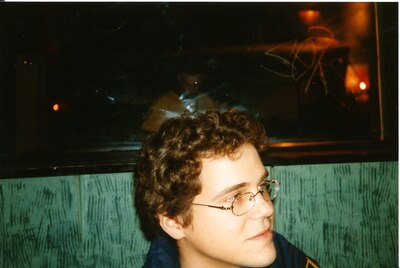

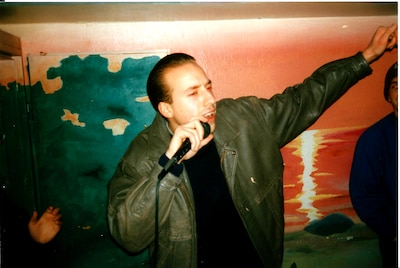
The teens of Kreuzberg knew these crews primarily through their activities and behavior on the streets. Early on, they established a reputation through graffiti and fights with the police. For some artists, the music merely functioned as a tool to spread their graffiti crew’s name. Frauenarzt, however, had a strong business sense and the required focus to keep the wild gang together. Gradually, the uncompromising tapes were produced in limited batches at Cassetten Copy Service, or CCS, in Berlin-Schöneberg. Frauenarzt explains, “My father made electro music during the ’80s, around the Kraftwerk phase. He had his own tape label and they produced all their cassettes at this store. So even back then, quality was already an important factor for me back then. I had a five-page, high gloss cover and stuff like that. I managed to get my hand on a stamp and stamped the first 50 editions myself.” The money for the first pressing came – very classily – from dealing hash.
Justus Jonas remembers the beginning at Royal Bunker as well. “Staiger and Jack Orsen sat on the floor day and night, packed up the tapes and sent them out. I just never understood where all the orders came from. How did people know about us?” While only radio-friendly rap artists that were more on the pop side of things, like Freundeskreis or Absolute Beginner, made it into the German charts, an heady new sound was being developed in the basements and backyard apartment of West-Berlin. And slowly but surely, the country took notice of the then-burgeoning underground.
The production amounts rose from 100 to 500 editions per tape. With their cheap rental cars, a couple of guys started chugging on ailing highways to East Germany, where they would perform at youth clubs and even smaller locations. “We also drove down to Splash! Festival to sell our tapes. But we never got proper feedback. There was no internet back then or it was at least only in progress,” Jonas says. At this point, the scene’s participants had absolutely no means to recognize the hype that had slowly evolved around them. “I remember we got booked at some random hillbilly village” Jonas remembers, while the fight between the two squabblers in the pub keeps escalating. “We expected there would be around 15 acts but it was just us. When we arrived, there were hundreds of fanatic fans who completely lost it. They knew all our lyrics by heart.” Through the graffiti store in Berlin and other methods, like mail-order or underground magazines, the tapes spread across the whole country and caused a phenomenal stir.
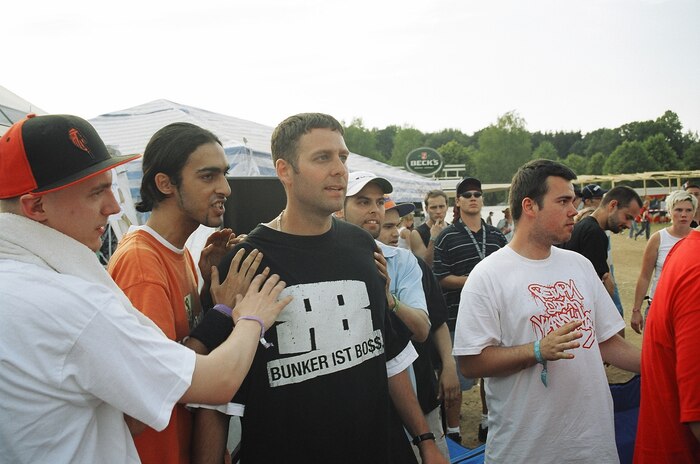
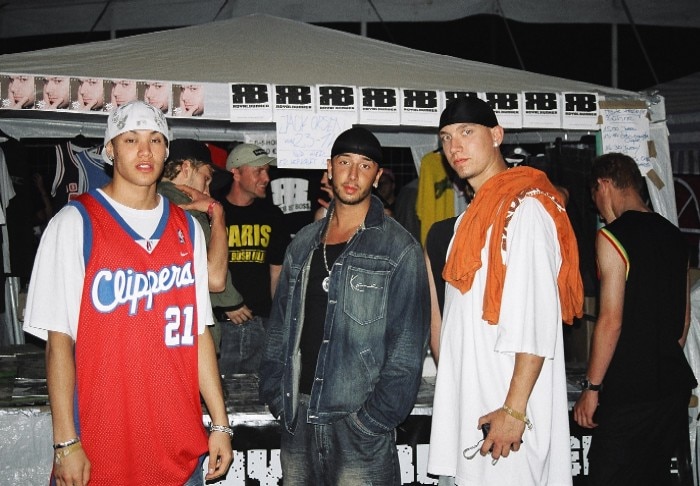
All of a sudden, even the industry started to take interest in the street urchins of the scene. Distributors like Groove Attack or Beatillz began selling tapes, 500 copies becoming 1,000 copies, and the loose idea of making music transformed into a business model. Staiger remembers, “We made some money with the tapes, sure. But the industry still laughed at us. At one event, someone said, ‘Well, you guys only sell tapes.’ ‘That’s right, but we sell 8,000 tapes,’ I replied. This always staggered them. Other rap acts from Berlin who they tried to make big – like Spezializtz – only sold 10,000.”
Beyond the by-then somehow profitable business, the music left a lasting impression. Next to both camps, Royal Bunker und Bassboxxx, there was a third crew that would soon become the talk of the town: Die Sekte. But among all these crews, it wasn’t always love, peace and harmony. The occasional brawl on basketball courts was part of the game. But they were all connected by their sound: hard but full of humor, outshining everything that had happened before. Breaking taboos and transgressing limits weren’t simply expedient – they were an inevitable part of their artform. Moreover, this was a melange of people from diverse backgrounds and classes who shared the same passion: immigrant children, sons of academics and professors, expats, original Berliners, college kids and kids that didn’t even finish high school.
The results were punchlines that were relatable to everyone in their audience, mostly those of a young, trigger-oriented age. In a relatively short period of three or four years, dozens of spirited Deutschrap classics came into life – without any professional help. As Mach One detected back then: “Good rap only grows in dirt.”
This could have gone on forever, at least if it were up to us. But, of course, it turned out differently. While some MCs emerging from the Royal Bunker camp started their solo careers with assistance from major labels – with Kool Savas leading the way – and the technical progress started to kill the demand for tapes, deep down in the underground a crew evolved that would soon not only electrify rap fans but would turn all standards of the major industries upside down. This was the birth of Aggro Berlin.
Together with his partner Spaiche and the graphic mastermind Specter, the owner of the graffiti store Downstairs had acknowledged the potential of hard rap from Berlin’s streets. The three of them started to professionalize the business in an unprecedented way, and began building their empire. The label Aggro Berlin, with their locomotives Sido and Bushido (who would leave the label shortly after), came as a real bombshell and eventually sealed the deal on the end of Berlin’s underground culture. Heavy rotation on all channels, chart position and plenty of golden records, together with a complete elimination of the earlier rap strongholds, Hamburg and Stuttgart, off the hip-hop map were the consequence. Suddenly, the former underground was the predominant sound and the industry tried to manufacture similar artists with lightning speed. They were sometimes successful, sometimes not. But rap from Berlin’s streets had finally made it to the top. The tapes disappeared, and CDs became the leading medium.
Not everyone profited from the hype. Staiger’s label Royal Bunker still released new albums constantly, but the second generation wore out their forefather’s fame. While artists like Kool Savas, Sido, Bushido, Fler or Frauenarzt & Manny Marc became established figures of the industry, the likable underdog label spiraled down in debt with no escape.
Nevertheless, a few years later Staiger started the so-called Streetoffensive in 2007. Due to their dedication to the old concept, they pressed some CDs for the underground market as a countermove: “At last, this was a promotion tool that helped our cash flow a bit. We stood outside every concert in Berlin and sold the records. Just like the good old times. Once we stood at a Samy Deluxe concert where I sold a mixtape to Eisfeldt [one of the most successful rappers from pre-tapes times] on which he was shot in one skit. I only realized it later, but I think he is still mad. This method of distribution helped our artists to get more reach, but it didn’t stop our financial downward spiral.”
With the release of K.I.Z.’s first album, Staiger was finally able to find a good ending for the label, while simultaneously proving once again that he still had an instinct for artists that would eventually fill huge arenas. Nowadays, the band is one of the most successful groups in Germany. They still use the premises of the old Royal Bunker office as their studio.
What’s left from this golden era of tapes are not just memories, but many artists who have shaped modern Deutschrap: One of Germany’s most successful genres and the number one youth movement. There are also a few tapes left. And in case you own one of these first editions, you can count yourself lucky: The earliest version of Westberlin Maskulin’s tapes by Taktloss and Kool Savas was recently sold online for almost €1,000.
